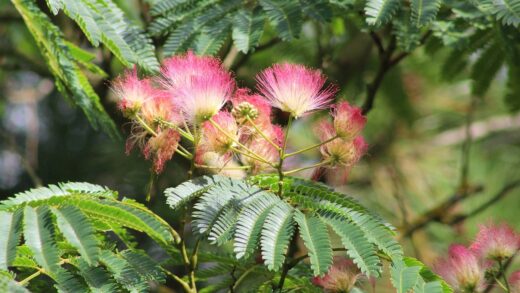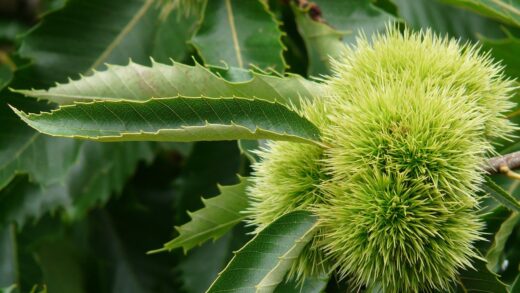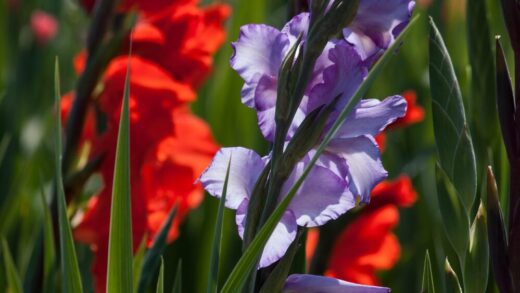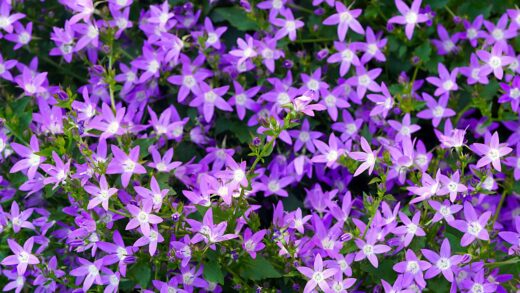Understanding common bluebell diseases
Fortunately, the native English bluebell is a resilient plant that is not prone to a wide array of diseases, especially when grown in conditions that mimic its natural habitat. However, like any plant, it can fall prey to certain pathogens, particularly when stressed by poor growing conditions such as waterlogged soil or overcrowding. The most significant disease threat is bluebell rust (Uromyces muscari), a fungal infection that manifests as small, dusty, yellowish-orange or brown pustules on the surfaces of the leaves. In severe infections, these pustules can cover the leaves, impeding photosynthesis and causing them to wither and die prematurely.
While rust is rarely fatal to the bulb itself, a severe infection can significantly weaken the plant. By reducing the leaf’s ability to photosynthesize, it limits the amount of energy that can be stored in the bulb for the following year’s growth. This can lead to a reduction in flowering and a general decline in the plant’s vigour over time. The fungus thrives in damp, humid conditions with poor air circulation, which is why overcrowding can exacerbate the problem. The spores can be spread by wind and water splash, allowing the disease to move through a dense colony.
Another potential issue, though less common, is grey mould (Botrytis cinerea). This ubiquitous fungal disease can affect bluebells, particularly during prolonged spells of cool, wet weather. It typically appears as a fuzzy, greyish-brown mould on fading flowers or on leaves that have been damaged. In severe cases, it can spread to the flower stalks and even down to the bulb, causing rot. Good garden hygiene, such as removing faded flowers and any damaged foliage, can help to prevent the disease from taking hold.
The most serious threat to the bulbs themselves is rot, which is not a single disease but rather a symptom caused by various soil-borne fungi and bacteria. Bulb rot is almost invariably a result of poor growing conditions, specifically soil that is too heavy and remains waterlogged, especially during the dormant period. The bulbs will become soft, discoloured, and mushy, and the plant will fail to emerge in the spring. This highlights the absolute importance of ensuring excellent drainage when planting bluebells, as prevention through proper soil preparation is the only effective cure for bulb rot.
Preventative measures and garden hygiene
The most effective strategy for managing diseases in English bluebells is prevention. Creating a healthy growing environment that minimizes stress on the plants is the first and most important line of defence. This begins with selecting a suitable site with dappled shade and, crucially, preparing the soil to ensure it is rich in organic matter and free-draining. Well-drained soil prevents the waterlogged conditions that are the primary cause of bulb rot and that can encourage other fungal pathogens. Healthy, vigorous plants growing in ideal conditions are naturally more resistant to diseases.
More articles on this topic
Good air circulation is also vital in preventing fungal diseases like rust and grey mould, which thrive in stagnant, humid air. This is where proper spacing and colony management come into play. When planting new bulbs, ensure they are spaced at least 10 centimetres apart to allow air to move freely between the plants as they grow. For established colonies, it is important to divide overcrowded clumps every few years. This not only reinvigorates the plants but also improves airflow, making the foliage less susceptible to fungal spores landing and germinating.
Garden hygiene plays a significant role in reducing the amount of disease inoculum in the environment. At the end of the season, once the bluebell foliage has completely died back, it should be carefully raked up and removed from the area, especially if you have noticed any signs of rust during the growing season. This material should be disposed of, preferably by burning or in municipal green waste, rather than being added to your home compost heap, as this can allow the fungal spores to survive and re-infect the plants the following year. Similarly, removing any faded flowers can help to prevent grey mould from developing.
Finally, be mindful of your watering practices. When supplemental watering is necessary during the spring, it is best to water the soil at the base of the plants rather than overhead. Wetting the foliage, particularly in the evening, can create a film of moisture that provides the perfect environment for fungal spores to germinate. Watering in the morning allows the leaves to dry quickly as the day warms up. These simple, preventative husbandry techniques are far more effective than relying on chemical treatments and contribute to a healthier overall garden ecosystem.
Identifying and managing bluebell rust
Bluebell rust is the most likely disease you will encounter on your plants, so being able to identify it early is key to its management. The tell-tale signs are the appearance of small, distinct pustules on the leaves and sometimes on the flower stalks. Initially, these may be yellowish-orange, but they often darken to a rusty brown or black as the season progresses. These pustules contain the fungal spores, and if you were to wipe a finger across them, a dusty, rust-coloured powder would come off. The infection typically starts as a few scattered spots but can spread to cover large areas of the leaf surface in favourable conditions.
More articles on this topic
Upon identifying the first signs of rust, the best course of action is to carefully remove the infected leaves. This should be done with care to avoid shaking the leaves and releasing a cloud of spores that could spread to neighbouring healthy plants. Place the removed foliage directly into a bag and dispose of it away from the garden. For a small infection caught early, this simple act of sanitation can be enough to halt its spread and prevent a more serious outbreak. It is important to disinfect your tools, such as secateurs, after cutting off infected material to avoid accidentally spreading the spores to other plants.
In cases where the infection is widespread throughout a colony, removing all the foliage is not a practical or desirable option, as the plants need their leaves to build up energy reserves. In these situations, the focus should shift to long-term management and prevention for the following year. The most critical step is to ensure a thorough clean-up in early summer after all the foliage has naturally died back. Raking up and destroying all the fallen leaf litter will remove a huge number of the overwintering spores, significantly reducing the potential for infection in the next spring.
While chemical fungicides are available for controlling rust on some ornamental plants, their use on bluebells is generally not recommended or necessary. The environmental impact of these chemicals often outweighs the benefit, and good cultural practices are usually sufficient to keep the disease in check. Improving air circulation by thinning out overcrowded clumps and ensuring a thorough autumn clean-up are the most effective and sustainable long-term strategies for managing bluebell rust in a garden setting.
Key pests affecting English bluebells
English bluebells are generally not troubled by a large number of insect pests, but there are a few creatures that can cause damage. One of the most significant, particularly to the bulbs, is the narcissus bulb fly (Merodon equestris). The adult fly, which resembles a small bumblebee, lays its eggs in late spring near the base of the bluebell leaves. When the larva hatches, it burrows down into the soil and into the bulb. The maggot then spends months inside the bulb, hollowing it out by feeding on its centre. This damage often goes unnoticed until the following spring when the plant either fails to emerge or produces only a few weak, distorted leaves.
Unfortunately, once a bulb is infested with the narcissus bulb fly larva, there is no cure. The only solution is to dig up and destroy the affected bulb to prevent the larva from pupating in the soil and emerging as an adult fly to continue the cycle. You can identify an infested bulb by its soft, spongy feel when gently squeezed. If you cut it open, you will find a single, large, plump maggot inside. Vigilance is key; look for small, unhealthy-looking plants and investigate them. Planting bulbs deeply (15 centimetres) can also offer some protection, making it harder for the newly hatched larvae to reach the bulb.
Slugs and snails can also be a nuisance, especially in the damp, shaded conditions that bluebells love. They are particularly fond of the tender new shoots as they emerge in the spring and can also graze on the leaves and flowers. While they rarely cause fatal damage to an established colony, they can be a significant problem for young seedlings and can make the foliage and flowers look ragged and unattractive. There are numerous methods for controlling slugs and snails, ranging from beer traps and manual removal at night to the use of wool pellets or grit as a barrier around the plants.
Less commonly, aphids may infest the leaves and flower stalks, particularly if the plants are under stress. These small, sap-sucking insects can cause distortion and weakening of the plant, and they excrete a sticky substance called honeydew, which can lead to the growth of sooty mould. A strong jet of water from a hose can often be enough to dislodge a small infestation. In more persistent cases, an application of insecticidal soap can be effective. However, widespread pest problems are rare, and a healthy bluebell colony will typically be able to withstand minor pest attacks without significant issue.
The threat of the Spanish bluebell
Perhaps the greatest long-term threat to the health and integrity of the native English bluebell is not a disease or a pest, but another plant: the Spanish bluebell (Hyacinthoides hispanica). Introduced as a garden plant, the Spanish bluebell is more vigorous and less particular about its growing conditions than its native cousin. It can tolerate more sun and a wider range of soil types, allowing it to thrive in many garden environments. The problem arises because the two species are closely related and can readily cross-pollinate and hybridize.
The resulting hybrid, Hyacinthoides × massartiana, is often highly fertile and vigorous, possessing traits from both parents. These hybrids can then back-cross with the native species. Over time, in areas where both species are present, this extensive hybridization leads to the genetic dilution of the native English bluebell population. The unique characteristics of the native species – the delicate, one-sided arch of the flower stem, the deep violet-blue, narrow, bell-shaped flowers, and the sweet scent – are gradually lost, replaced by the paler, more open, unscented flowers of the hybrid.
Identifying the different species is crucial for conservation. The native English bluebell has a distinctly drooping or nodding stem, with all the flowers hanging from one side. The flowers are a deep blue, tubular with strongly recurved tips, and have a beautiful, sweet scent. The pollen is creamy-white. In contrast, the Spanish bluebell has a much more upright, erect flower stalk with flowers arranged all around the stem. The flowers are paler blue, more open and conical, have no scent, and the pollen is blue. The hybrid exhibits a range of intermediate characteristics.
If you wish to grow native English bluebells, it is vital to source your bulbs or plants from a reputable supplier who can guarantee they are true, native stock. If you discover that you have Spanish bluebells or hybrids in your garden, the responsible action is to remove them to prevent them from cross-pollinating with any native populations in your garden or the surrounding area. This involves digging up the bulbs completely, as they are very persistent. This proactive management is essential to protect the genetic integrity of one of the UK’s most beloved wildflowers for future generations.


















